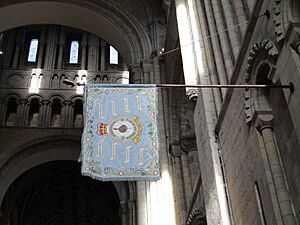RAF squadron standards and battle honours facts for kids
RAF squadron standards and battle honours are special ways the Royal Air Force (RAF) shows its history and amazing achievements. Think of them like awards and flags that tell the story of a squadron.
Squadron standards are beautiful, ceremonial flags given to squadrons that have done something really special. Battle honours are like special mentions or awards for important battles or missions where the squadron's people took part.
Contents
Squadron Standards
What Are Standards?
For a very long time in British history, military leaders used special flags called 'standards'. These flags helped soldiers know where to gather during a battle. They also showed how the fight was going.
How Standards Started in the RAF
The idea of squadron standards for the Royal Air Force began during World War II. In 1943, on the RAF's 25th birthday, King George VI announced that he wanted to give standards to squadrons that were actively flying missions.
To earn a standard, a squadron had to meet certain rules. They either had to serve for 25 years in the RAF, Royal Auxiliary Air Force, Royal Naval Air Service, or Royal Flying Corps. Or, the King could give them a standard for being incredibly brave or successful during their operations.
The very first standards were given out in the 1950s. Thirty squadrons received them for their long service. A famous example is No. 617 Squadron. They earned their standard for their amazing part in Operation Chastise in May 1943. This mission is also known as the 'Dambuster Raid'.
How Standards Look
Squadron standards are quite large, measuring about 122 centimeters (4 feet) wide and 247 centimeters (81.2 inches) long. They are handmade from light-blue silk. They have blue and gold fringes and tassels around the edges.
Along the border, you'll see embroidered roses, thistles, shamrocks, and leeks. These are the national symbols of the different parts of the United Kingdom. In the middle of the standard, there's an embroidered picture of the squadron's special badge. Below the badge, there are scrolls that show up to ten battle honours the squadron has earned.
These standards are usually placed on a tall flagstaff that is about 246 centimeters (8 feet) high. The top of the flagstaff has a golden eagle with its wings spread out.
Battle Honours
The RAF started giving out battle honours when it was created in 1918. This idea came from the Army and Navy. Because of this, some RAF squadrons still carry honours they earned when they were part of the Royal Flying Corps or Royal Naval Air Service.
Battle honours are not given for every single mission. Only squadrons that were directly involved in fighting the enemy can earn them. A squadron can display the names of up to 10 battle honours on its standard. This is called "emblazoning the honour."
Here are some examples of battle honours that RAF squadrons can claim from different wars:
First World War Honours
Second World War Honours
- Battle of Britain 1940: For fighter squadrons defending Britain from August to October 1940.
- Berlin 1940–1945: For bombing missions over Berlin by Bomber Command.
- Dunkirk: For operations covering the evacuation of British and French forces from Dunkirk in May-June 1940.
- El Alamein: For operations during the retreat to El Alamein and later battles in June-November 1942.
- Normandy 1944: For supporting the Allied landings in Normandy and the breakthrough in June-August 1944.
- The Dams: For squadrons that took part in breaching the Mohne, Eder, Serpe, and Kembs Dams in May 1943. This is part of Operation Chastise.
- Tirpitz: For operations that led to the sinking of the German battleship Tirpitz.
Post-1945 Honours
- South Atlantic 1982: For service during the Falklands War from April to June 1982.
- Gulf 1991: For operations against Iraqi forces in Kuwait in January-March 1991.
- Kosovo: For RAF support during the air campaign over the Federal Republic of Yugoslavia in March-June 1999.
- Iraq 2003-2011: For RAF operations in Iraq after the 2003 invasion.
- Afghanistan 2001-2014: For RAF support to operations in Afghanistan.
- Libya 2011: For RAF support during the military action in Libya in 2011.


